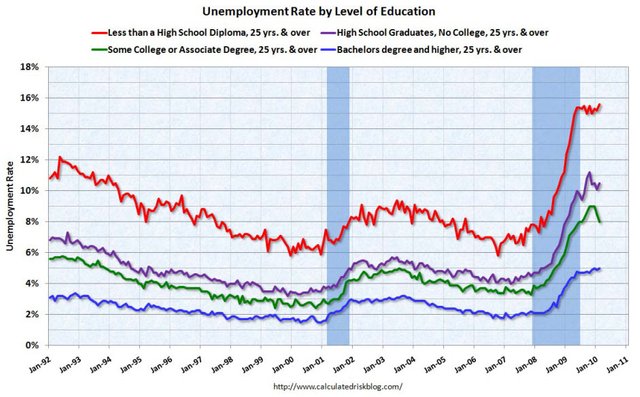The strange proportion ... Why the greater the number of educated increased unemployment ?!
The high level of education of the labor force is a phenomenon we all see. The mid-fifties of the last century witnessed rapid and rapid growth in the average level of education for the civilian labor force, both in developed and developing countries, the differences between them being relative rather than absolute.
In the United States, for example, the number of people who spent eight years or less in formal education has dropped significantly while the number of those who have enrolled in the university has increased significantly. The 1960s, 1970s and 1980s witnessed a significant expansion in the number of people enrolled in universities, Who completed basic education during the same period.
The question that arises is: What do these trends mean? Is there a causal relationship?
These trends mean that those coming to the labor force, and thus to the labor market, are better educated than their predecessors. More importantly, new workers will replace poorly educated individuals. Differences in the level of formal education between new and old may reach four Or five or even six years of schooling.
The implications of this new situation for the labor force are profound. Young people who join the labor force in the years to come will be much better educated and educated than those who will replace them.
Education in all countries of the world was considered a tool for class advancement in the social ladder, as a means of improving income, as well as for raising the level of individual satisfaction with life in general. There is also a close relationship between the level of education and unemployment. Great compared to others.
If historical evidence supports this view of education, recent evidence has begun to question this assumption.
Unemployment rate by educational level in the United States from 1992 to 2011
According to the Bureau of Labor Statistics in the United States of America, only 20% of the jobs require higher education than the secondary level.
Today we find that one in four workers entering the workforce has a university degree, while in 1970 we found one out of eight workers with a university degree.
Therefore, these countries must create jobs for university graduates. If there are a large number of educated people, and few jobs, this can lead to a major problem that is unemployment.
This problem is especially affecting sectors that require workers in regular jobs, which do not require a lot of efficiency, in which cases workers usually remain in jobs that require education requirements and high efficiency because of their lack of presence and need.
This situation in itself is positive or negative, but these numbers are beginning to threaten, if new jobs are not created quickly enough to accommodate new graduates with higher degrees.
If new industries and modern fields of labor require higher education, the supply of new labor market workers, with university and higher qualifications, is rapidly increasing the rate of creation of new jobs sufficient to absorb them.
The number of people with university degrees has risen much faster than the need for the labor market. The gap between the supply of qualified workers and the demand for labor in the labor market has increased over the past three decades. This has led many organizations and employers to try to bridge this gap. The functional requirements of the posts therein, without changing the nature of the functions themselves.
Sometimes this is done by the organizations to sort out job applicants or to raise the level or status of the job itself. However, this also stems from the belief that better educated workers are easier to train, more disciplined, more disciplined, more productive, flexible, mentally open, and motivated to work than their less educated peers.
This belief continues to prevail despite the fact that the correlation between the level of education of the worker and the level of his performance has not been proven. As a result of these trends, the level of education of the labor force has risen significantly, but on the other hand we see a new phenomenon. Qualified individuals, even in the United States and developed countries in general.
The high rate of unemployment among university graduates results in the inability of the system in any country to strike the required balance between the supply and demand of workers of different types and levels. This results in a large number of individuals working and will continue to work in jobs that are far below their requirements Scientific, practical and academic qualification.
Today, we are seeing individuals with a PhD in aircraft engineering and working as vendors in supermarkets.
These conditions, which are a recent phenomenon in developed countries, result in the inability of the free market system to strike the right balance between the skills of the incumbent and the requirements of the job itself.
On the other hand, despite the fact that there are large numbers graduating from each university, employers continue to warn of the risk of diminishing skills and experience of their staff, as well as the difficulty of finding suitable staff to run their businesses.
According to a McKinsey study in 2012, published under the heading "From Education to Employment", fewer than half of the interviewees saw university graduates lack the skills needed for the job market. Large business owners assert that jobs are available but young people do not have the skills to fill them.
If this is the situation in the developed countries, then we are the developing countries, especially the Arab countries, which suffer from poorly planned manpower at the national level, and not linked to the educational policy of the state. Which was prevalent for a long time - the sixties of the last century in Egypt, for example - but also blatant unemployment, in addition to the irrational use of this highly qualified workers, and waste of what can be called the strategic workforce in the state.
According to a World Economic Forum report by the end of 2014, youth unemployment in the Arab region is the highest in the world, reaching 27.2% in the Middle East and over 29% in North Africa, more than double the world average .
We have to pause for a moment to ask who is the main culprit for the high rate of unemployment among the educated? Is it the output of higher education, which injects huge numbers annually from those who have certificates in specialties that overshadow the life of the market? Or is the labor market itself small and failing to create new jobs that accommodate the growing number of graduates? Share your opinions and comments on this major dilemma ...
I hope that my explanation has benefited you



Este Post ha recibido un Upvote desde la cuenta del King: @dineroconopcion, El cual es un Grupo de Soporte mantenido por 5 personas mas que quieren ayudarte a llegar hacer un Top Autor En Steemit sin tener que invertir en Steem Power. Te Gustaria Ser Parte De Este Projecto?
This Post has been Upvote from the King's Account: @dineroconopcion, It's a Support Group by 5 other people that want to help you be a Top Steemit Author without having to invest into Steem Power. Would You Like To Be Part of this Project?
You've hit the mark.
This post has been ranked within the top 50 most undervalued posts in the second half of Aug 24. We estimate that this post is undervalued by $21.09 as compared to a scenario in which every voter had an equal say.
See the full rankings and details in The Daily Tribune: Aug 24 - Part II. You can also read about some of our methodology, data analysis and technical details in our initial post.
If you are the author and would prefer not to receive these comments, simply reply "Stop" to this comment.